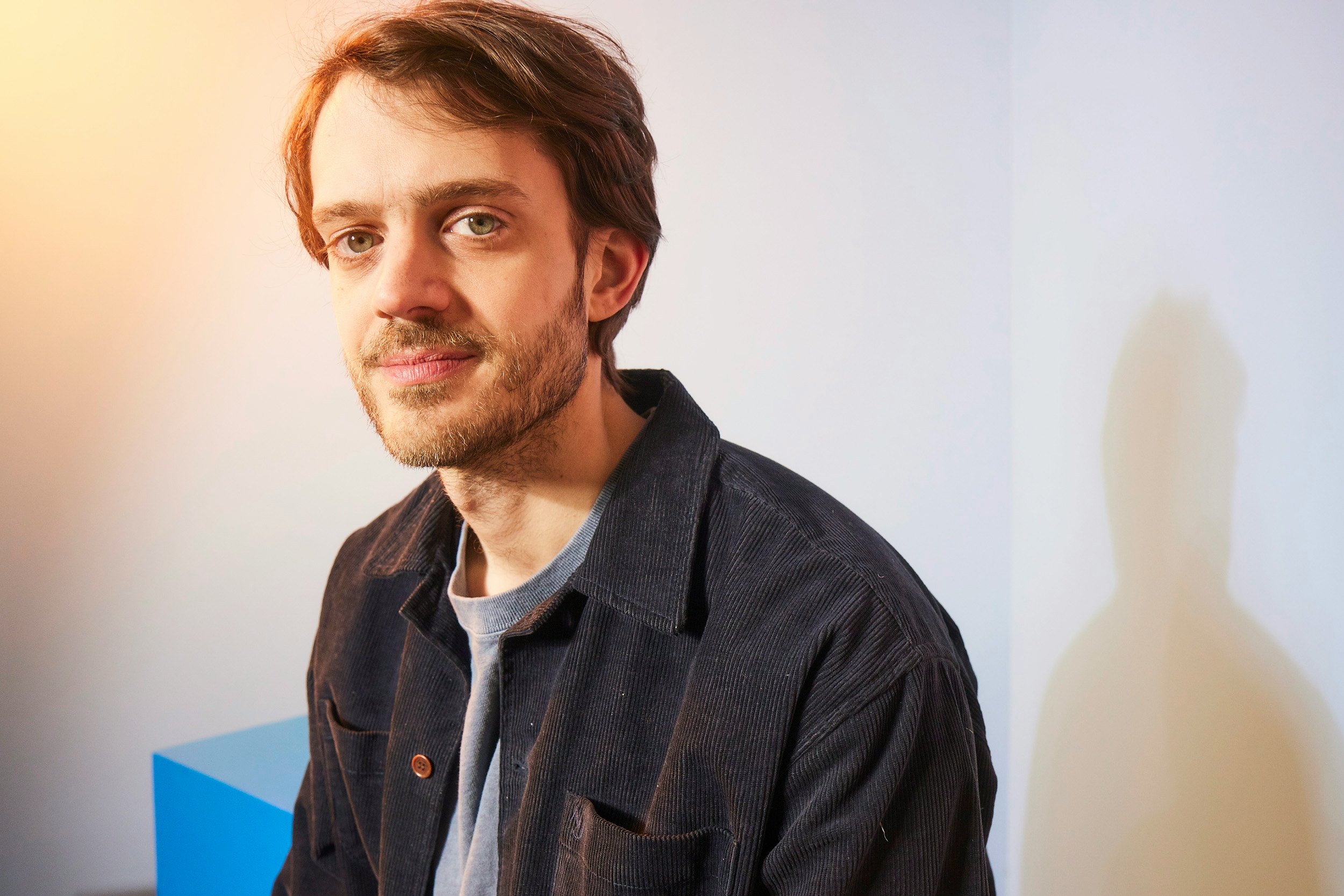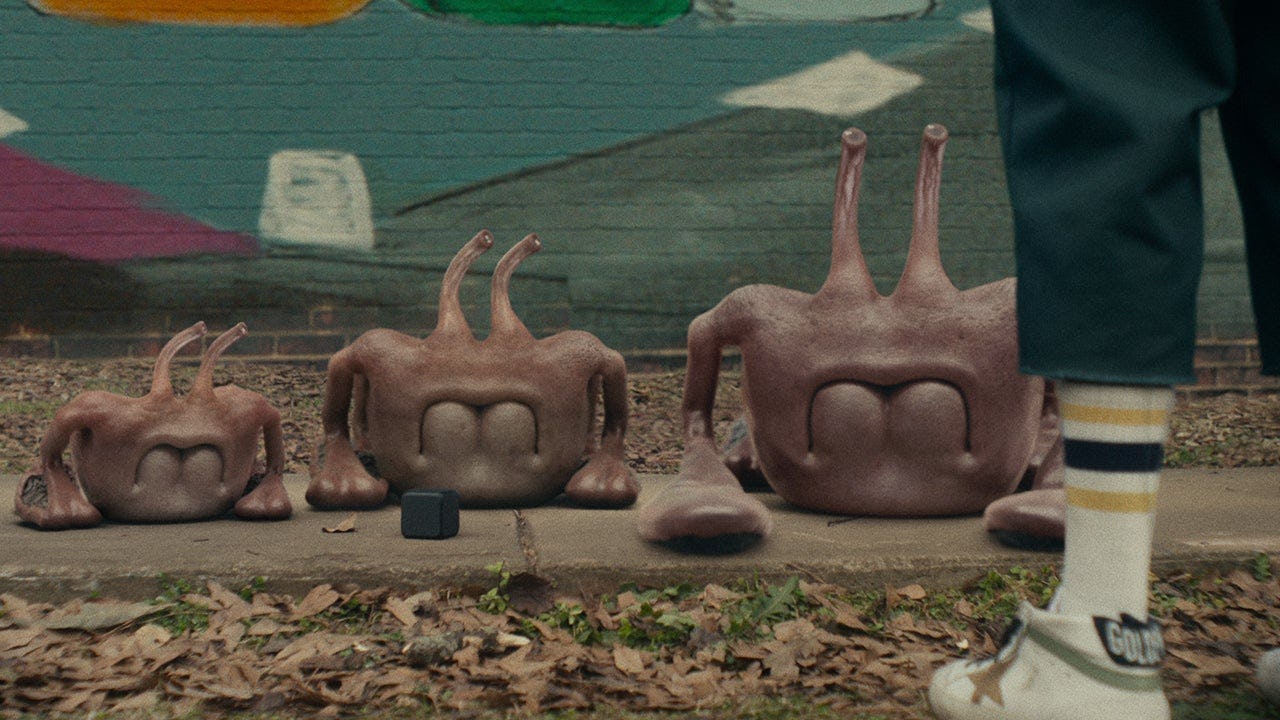
Cory Finley’s career path is anything but conventional. The writer/director first rose to prominence as a playwright, with his play The Feast now a mainstay at all the coolest college theater programs. He successfully turned his stage script Thoroughbreds into a cult favorite indie film starring Anya Taylor-Joy and Olivia Cooke, then pivoted to the star-studded HBO film Bad Education.
“I’m a very restless filmmaker,” Finley tells Inverse. “When I spend the two to three years that it takes to finish a film on a movie, I’m very done with that world and that tone, and I want something that’s a really radical reaction to that.”
That radical reaction came to be Landscape With Invisible Hand, a heartfelt sci-fi story about the effects of an alien invasion on family life and a burgeoning teen romance. Based on M.T. Anderson’s book of the same name, the film is a far cry from Finley’s past in pitch-dark comedy, but the heart and soul — and eerie atmosphere — of his entire filmography is present throughout.
“[The book] was just incredibly wacky and bizarre and hard to visualize as a movie in a good way,” Finley says, “a way that felt like a sort of gauntlet being thrown. It just really stuck in my head and wanted to work on it for years.”
Finley spoke to Inverse about adaptation, his sci-fi influences, and his future steps — including which genre he wants to tackle next.
This interview has been edited for clarity/brevity.

Is it easier to adapt your own play or someone else’s novel?
Oh, that’s a very good question, and I feel I’m in the rare position of being an authority on that. They’re very different. I’d say it was a simpler transition with Thoroughbreds. It ended up being helpful that it had these really long, dense dialogue scenes as so many plays do.
It was a really good first screenplay for me. I could just plug in the best of the greatest hits of those scenes into shorter little dramatic scenes to fit the tempo of film. Because I had these very dialogue-heavy sections, I could build these purely visual sections around those.
With Landscape, it was a very different beast for sure, because it’s just the form of a novel and particularly a novel with the really specific cool tone as this — it’s a very specific thing. It certainly took more invention and creation than adapting my own play, but it was a super rewarding process.
“I’m drawn to any story where you have competing tones that have to be wrangled and smashed together in interesting ways.”
How do you balance that sci-fi world building with the deeply emotional core of Landscape With Invisible Hand?
Your question highlights exactly what I liked about the story: It’s really quite dark, in some ways, almost a tragedy. It has hopefully a little bit of an earned happy ending, but it’s a really dark world that’s being depicted.
But the book did it with such joy and such unabashed silliness butting right up against the deep seriousness. I’m always drawn to that kind of tone, I’m drawn to any story where you have competing tones that have to be wrangled and smashed together in interesting ways.
Where did you get the inspiration for the Vuvv alien designs and the language?
That was probably the single biggest undertaking of this project, designing the Vuvv. Often when you’re adapting sci-fi material, you’ll have maybe a graphic novel or an older movie or a toy or something that you can begin your visual design process with. What I loved about M. T. Anderson’s book is its very, very sparse and evocative in its descriptions of the Vuvv.
You never really get a full head-to-toe description. You get little bits. “They were sort of squat like coffee tables” is one of the lines, or “they communicated by rubbing a gritty fin against their body, and it sounds like someone walking forcefully in corduroys.” I love those sorts of literary descriptions, but obviously they still leave a lot of “where’s the elbow connected to the knee, connected to the head” questions.

I worked closely with a guy named Erik De Boer who was a really key collaborator on this. He was our VFX supervisor. He had previously worked with Bong Joon-Ho on Okja; he created that super pig, which I thought was a real landmark in visual effects and creature design. I really bought it and I had an emotional reaction to it. So we just iterated endlessly with a bunch of concept artists and tried a bunch of wacky ideas.
What sci-fi movies did you look for inspiration for this?
Particularly for the visual language of the movie, my DP Lyle Vincent and I really wanted to consciously avoid the standard sci-fi visual tropes. We did not want to go for really bold, widescreen anamorphic with big juicy lens flares and perfectly sharp cinematography. We wanted something keeping with the themes of the movie that was earthy and almost humble and human-sized.
“The glib answer would be it’s like Thoroughbreds in space.”
So we went for this slightly unusual 1.66 aspect ratio. One of the reasons we picked that is it’s the aspect ratio of a bunch of Kubrick movies of which we’re both big fans, particularly Clockwork Orange, and that’s an incredibly different movie thematically. But we kept returning to it as an inspiration because it was a futuristic movie almost like 2001, another great movie really does not feel like almost any other sci-fi movie.
It feels even stranger than a Blade Runner or a Solaris or one of these sort of broken-down visions of the future. It’s almost more of an alternate present than a future. And we kept looking to that for the visual feel of the movie.
You’ve directed, like you said, a variety of genres and tones. What’s on your wish list? What do you want to do next?
I definitely want to be a genre-hopping director. I always keep saying one day I want to take on a Western, I haven’t found the right one. One project that’s in the hopper now is very much a psychological thriller, which I suppose I have done before with Thoroughbreds, but that’s just a favorite genre of mine. So I’ll definitely return to that.
I don’t know, a war movie? I want to try everything, but I don’t think I’ll ever want to take on material that doesn’t have an element of humor and an element of seriousness. The two that I don’t think I’d ever do are just totally straight drama and totally broad comedy. I can appreciate those, but it’s just not my wheelhouse.

How would you describe this movie for fans of Thoroughbreds?
The glib answer would be it’s like Thoroughbreds in space. I did once have an executive at a big company say to me “We love the Thoroughbreds script, but we would never do Thoroughbreds. We would maybe do Thoroughbreds in space,” meaning they do like $100 million movies and not these little $2 million movies.
But in this case, I’d probably pitch it the same way I pitch it to anyone, which is it’s the story of a young man growing up, finding his voice as an artist, and falling in love in a world that’s been taken over by aliens. But the twist is that the aliens are not big scary dominators, they’re small, annoying bureaucrats that have taken on over our world via the free market.
What’s your opinion on the ongoing writers and actors strike? And are you glad that indie movies like this are accepting interim agreements to continue production?
I think both of the unions have handled their struggle really well. I’m a proud multiple union member. I’m here today really only as a director, I very much stand in solidarity with the WGA. I stand in solidarity with SAG. This movie is not directly about AI, I started writing it before ChatGPT really became a cultural thing. But certainly the fear of AI that you might read into the movie is something I feel in my bones. I certainly sympathize with that and with just the simple struggle for better pay and residuals.
I am certainly glad that some indie movies can continue to shoot, I think that’s an important provision and will help keep the industry vital through this necessary but difficult time.







